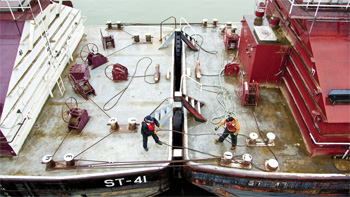The Coast Guard’s proposed rule change to transition the marine towing industry from uninspected to inspected status is pregnant with unknowns. A major mystery is when the Coast Guard will birth 46 CFR Subchapter M. Another much pondered uncertainty is what will be the minimum manning requirements on tugboats and towboats imposed by the rule change when they become inspected vessels.
Searching for guidance on the manning question, the Coast Guard requested the Towing Safety Advisory Committee (TSAC) to formulate recommendations for minimum manning requirements for the safe operation of towing vessels operating on rivers, lakes, bays and sounds — plus domestic near-coastal and ocean voyages and foreign voyages.
In turn, among other sources including the Offshore Marine Service Association, TSAC asked American Waterways Operators (AWO) to engage its member companies to provide input based on the manning scenarios each has adopted in response to operating in the real world of a multifarious segment of the marine industry.
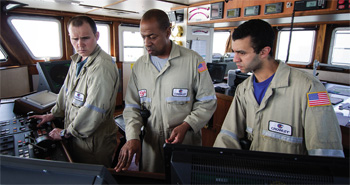 |
|
From left, steersman Tom Tramutola, Capt. Calvin Patterson and second-mate-in-training Dave Cunningham navigate the ATB Legacy with gasoline barge 750-1 from Louisiana to Florida. |
“AWO participates very actively in the work of TSAC,” said Jennifer Carpenter, who has been with AWO since the Oil Pollution Act of 1990 and is executive vice president. “I think it is the most productive advisory committee I’ve ever seen. We thought it was very constructive that the Coast Guard asked TSAC to take a deeper dive into the issue. Manning is a very important policy area and we think it is really going to be important when Subchapter M rules finally come out, whenever that is, that we’ve got good supporting policy that is also ready to go.”
Cathy Hammond, vice chair of TSAC and chief executive of Inland Marine Service, of Cincinnati, and Michael Vitt, vice president operations and general counsel of E.N. Bisso & Son Inc., in New Orleans, co-chaired the TSAC subcommittee on Manning of Inspected Towing Vessels. The recommendations were approved by TSAC members at a September 2013 meeting in Chicago. They now reside with the Coast Guard to consider during its revisit of the Marine Safety Manual Vol. III.
In October, Vitt and TSAC subcommittee member Steve Huttman, director of marine operations for G & H Towing of Galveston, Texas, discussed the subcommittee’s work at the Towing Forum held at SUNY Maritime’s campus at Fort Schuyler.
Vitt explained that the recommendations covered vessels operating domestically. The work on manning for vessels engaged in international service continues, awaiting changes to Standards of Training, Certification and Watchkeeping (STCW) that might affect the final requirements.
“For towing overseas, STCW adds another layer of complexity,” said Vitt. “TSAC is asking for help in determining what the manning requirements are for different types of cargo and tows conducting international voyages.”
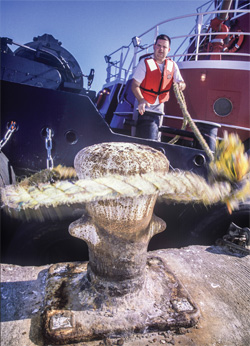 |
|
Able seaman Billy Hadley from the tugboat Matthew K throws a mooring line near Houston. |
Confusion cloaked the process because, coincidentally, the Coast Guard is in the process of revising the minimum manning requirements specified in the Marine Safety Manual (MSM). TSAC’s intent was not to deviate from minimum manning requirements ensconced in the MSM, but more to eliminate inconsistencies, coordinate repetition and organize the regulations to present clear, uncluttered recommendations for the Coast Guard to reference when the Officer in Charge of Marine Inspections (OCMI) issues a Certificate of Inspection (COI) to a towing vessel, post-Subchapter M.
“The task addresses both the MSM and Sub M to get manning into the same format as the Marine Safety Manual and align the two,” Hammond said.
The intent is that the Coast Guard will add towing vessel manning requirements as a separate section of the MSM. “We hope that in doing that they will draw heavily from the TSAC report,” said Carpenter. “The expectation is that when Subchapter M is law, the OCMI would look to that section of the manual addressing towing vessels inspected under Sub M.” The OCMI would then issue a COI for the vessel.
It is expected that the COI will specify the minimum manning requirements for each inspected vessel. A company’s Towing Safety Management System (TSMS) will provide the guidance to specify when additional crew above the mandated level are required. The International Safety Management Code (ISM) and AWO’s Responsible Carrier Program (RCP) are two examples of a TSMS.
TSAC’s recommendations, put forward in 2005, 2006 and 2011, were formalized in the task document. At the Towing Forum, Vitt explained that essentially the minimum manning recommendations thumbed the two-by-two rule. Generally, a towing vessel must have one licensed officer and an additional crewmember for operations under 12 hours. If vessel operations exceed 12 hours, an additional licensed officer (master, mate or pilot) and another crewmember must be added, or an alternate relief crew provided.
Furthermore, while a vessel is underway there must be at least one licensed officer and one additional crewmember on duty at all times. If a marine company has a TSMS, then additional manning may be specified on the COI or in its TSMS based on such specifics as the type and size of the tug, the towing applications and type of cargo being towed, and variables such as the configuration of the vessel superstructure, deck, engine room, etc.
“We are not reinventing the wheel,” said Huttman. “We’re organizing the regs and eliminating inconsistencies. You can’t define the towing industry as one specific segment. You have fleeting, barging, ship assist and escort, dangerous cargo. So you have to define manning for different companies doing different types of towing and assisting or towing different cargos. You have to make sure the appropriate personnel are aboard to do that job.”
Vitt added that the TSAC recommendations, if adopted by the Coast Guard, are to assist an OCMI in exercising discretion when establishing minimum manning requirements specified on the COI for a particular vessel.
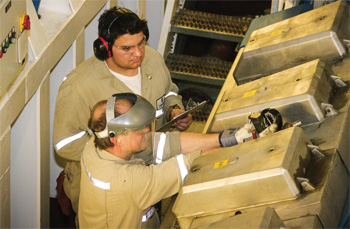 |
|
First engineer Butch Kates and third engineer Nicolas Littlepage check cylinder pressure aboard the ATB Legacy/750-1. |
“The OCMI may have different manning scales based on tow size and configuration, the number of barges, types of cargo, different routes, inland or offshore, and different regions,” said Vitt. “The Gulf of Maine, for instance, is partially inland but it might as well be considered ocean.”
The way Hammond sees it, the COI for Inland Marine Service boats, operating around the clock, will list a minimum of four crew, two licensed and two other crewmembers. “But in my case, because we have big boats and carry a crew of nine to 10 depending on the run, my COI would say four minimum and my SMS would list all of the additional positions that I have.”
It isn’t certain yet whether the COI would list the additional crew. There are industry concerns that if the Coast Guard chooses to have the positions listed, it may be, at the discretion of an inspector, perceived that the total number comprises the minimum manning requirement for that vessel.
When uninspected vessels become inspected, there will inevitably be capable but uncredentialed crew that will continue to perform the same duties on vessels performing the same towing functions. TSAC recommended that, for example, an unlicensed engineer, experienced and competent, should not be required to obtain a license just because the engineer’s vessel has become an inspected one. In effect they should be grandfathered in.
“The vessel the mariner is working on hasn’t changed and the nature of the mariner’s responsibilities hasn’t changed,” said Carpenter. “TSAC made several recommendations that were based on the thought process that a mariner who is working on a towing vessel today should not have to go out and get a credential, or a new kind of credential, solely because his or her vessel has changed status from uninspected to inspected.”
Vitt explained that TSAC assembled the subcommittee with representatives from a diverse collection of marine towing companies, large and small, with various types of towing vessels, ATBs, harbor tugs, fleeting and line haul boats, from different areas of the nation.
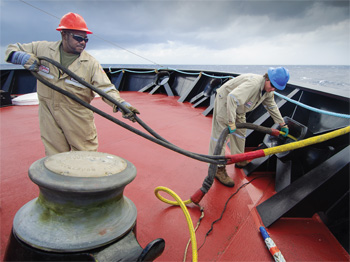 |
|
An ATB typically contains about one-third fewer crewmembers than an equivalent ship. Above, utility man Orvin McCoy and able seaman William Stubbs set up mooring lines on Legacy/750-1. |
TSAC asked AWO to do a survey of its companies regarding crewing. “The survey revealed that many companies crewed their vessels beyond requirements because it increases safety and is a sound business practice to do so,” said Vitt.
However, Vitt added that it is not the number of crew aboard, but it is important why they are there. “It is a discretionary area for the OCMI to determine manning depending on the company’s type of towing, number of barges and what the company’s TSMS requires, etc.”
For Hammond it is all about choice. “If I feel I need an additional deck hand, I put him on. If I need an assistant engineer, I put him on. I think that’s my issue. To me, this industry has been a very safe industry and why change something that’s worked. I think that once Subchapter M shows up there will have to be some additional work done. The TSAC recommendations are there, but who knows what the Coast Guard is going to do with them.”
Vitt explained that companies operating upon domestic waters typically crew their vessels according to their operational needs and business practice, not just regulatory requirements. Most often that philosophy led to larger crews than regulations required.
“The towing industry is already doing the right thing to keep the industry and its personnel safe,” said Vitt.

